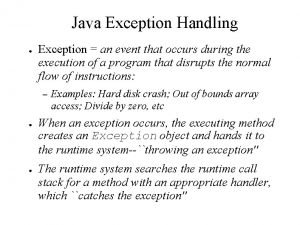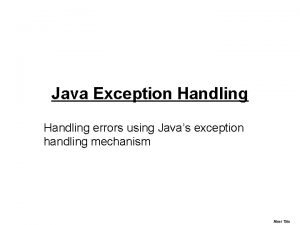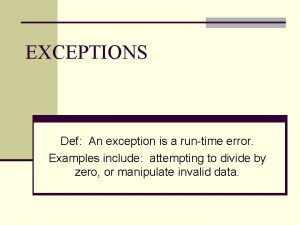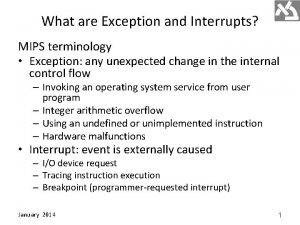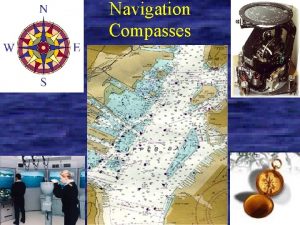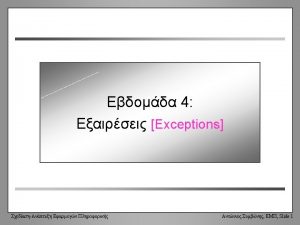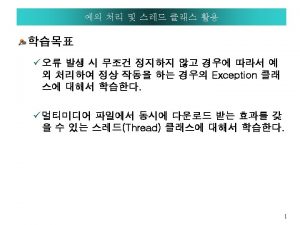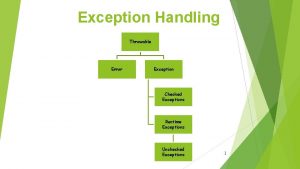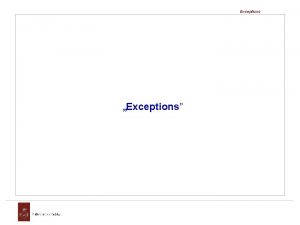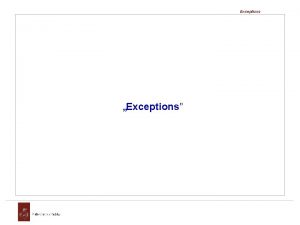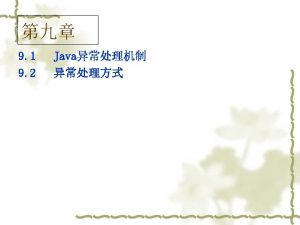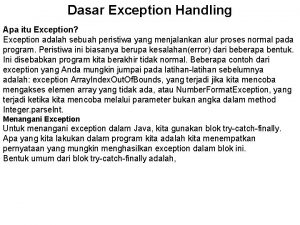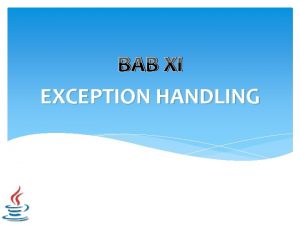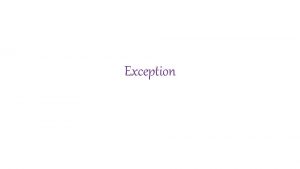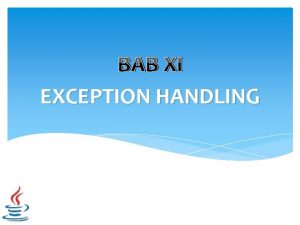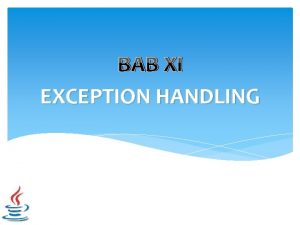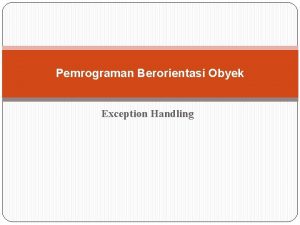Exceptions exception Exceptions 1 a program error that


















- Slides: 18

Exceptions exception Exceptions 1 a program error that occurs during execution, or a “signal” generated (“thrown”) when a program execution error is detected Exceptions may be thrown by hardware or software; we consider only the latter. If a software exception is thrown, and an exception-handler code segment is in effect for that exception, then flow of control is transferred to the handler. If there is no handler for the exception, the program will be terminated. Computer Science Dept Va Tech January 2002 OO Software Design and Construction © 2002 Mc. Quain WD & Keller BJ

Dodging an Error Exceptions 2 Frequently code will be designed to detect and avoid anticipated errors: void Rational: : Set. Denominator(int Denom) { if (Denom != 0) { Denominator. Value } else { cerr << “Illegal << “, using Denominator. Value } = Denom; denominator: ” << Denom 1” << endl; = 1; } Here we see a simple test and response, all handled locally. Computer Science Dept Va Tech January 2002 OO Software Design and Construction © 2002 Mc. Quain WD & Keller BJ

Handling an Error with an Exceptions 3 Here’s the same situation, handled now by throwing an exception: void Rational: : Set. Denominator(int Denom) { try { if (Denom != 0) { Denominator. Value = Denom; } else { throw (Denom); } } catch (int d) { cerr << “Illegal denominator: ” << d << “, using 1” << endl; Denominator. Value = 1; } } Computer Science Dept Va Tech January 2002 OO Software Design and Construction try block… On error: throw a value. catch thrown value, if any. © 2002 Mc. Quain WD & Keller BJ

C++ try-catch Mechanism Exceptions 4 A try block is simply a compound statement preceded by the keyword try. One, or more, of the statements in a try block can be a throw statement, or a call to a function that contains a throw statement. A throw statement resembles a function invocation, with information regarding the detected error wrapped within parentheses. A copy of the information in the throw statement may be passed via the throw statement to an exception handler that is keyed to the type thrown. The value thrown may be of a simple type (as on the previous slide), or a more complex structured type, including an object. That makes it possible to throw diagnostic information about the error. Computer Science Dept Va Tech January 2002 OO Software Design and Construction © 2002 Mc. Quain WD & Keller BJ

throw Not Caught Locally Exceptions 5 An exception may be thrown in one function and caught in another: void Rational: : Set. Denominator(int Denom) { if (Denom != 0) { Denominator. Value = Denom; } else { throw (Denom); } } no try block this time On error: throw a value. The thrown value, if any, must be caught elsewhere. Where? Resolved via the runtime stack’s record of the call sequence. Computer Science Dept Va Tech January 2002 OO Software Design and Construction © 2002 Mc. Quain WD & Keller BJ

Remote catch Exceptions 6 The exception may be caught in the function that called the one performing the throw: void Rational: : Rational(int Numer, int Denom) { Set. Numerator(Numer); try { Set. Denominator(Denom); } catch (int d) { cerr << “Illegal denominator: ” << d << “, using 1” << endl; Set. Denominator(1); } } Call may result in a thrown value, so we wrap it in a try block. Alternatively, the exception may be caught further back up the call sequence. Computer Science Dept Va Tech January 2002 OO Software Design and Construction © 2002 Mc. Quain WD & Keller BJ

Stack Unwinding Exceptions If a function throws an exception, and does not catch it, then control is transferred to the calling function, which is now given an opportunity to catch the exception. When the exception is caught, the catch block is executed and then the catching function may resume execution. 7 H() G() F() main() runtime stack This process continues until either a function catches the exception or all calls have been unwound. In the latter case, the program is terminated. Computer Science Dept Va Tech January 2002 OO Software Design and Construction © 2002 Mc. Quain WD & Keller BJ

Multi-Level Unwinding Exceptions 8 void create. List(int* Array, int Size); int get. User. Input( ); void main() { int* Array; int Dimension; try { create. List(Array, Dimension); } catch (int e) { cerr << "Cannot allocate: " << endl; return; } catch (bad_alloc b) { cerr << "Allocation failed" << endl; return; } Exception thrown in a called function. } Computer Science Dept Va Tech January 2002 OO Software Design and Construction © 2002 Mc. Quain WD & Keller BJ

Multi-Level Unwinding Exceptions 9 void create. List(int*& Array, int Size) { Size = get. User. Input(); } try { Array = new int[Size]; } catch (bad_alloc b) { // you can catch an exception throw (b); // and re-throw it } int get. User. Input( ) { int Response; cout << "Please enter the desired dimension“ << endl; cin >> Response; if (Response <= 0) { throw (Response); // caught in main() } return Response; } Computer Science Dept Va Tech January 2002 OO Software Design and Construction © 2002 Mc. Quain WD & Keller BJ

Specifying Potential Throws Exceptions 10 The potential for a function to throw an exception may be explicitly shown: int get. User. Input( ) throw(int) { int Response; cout << “Please enter the desired dimension” << endl; cin >> Response; if (Response <= 0) { throw (Response); // caught in main() } return Response; Warns user that a value may be thrown and also restricts what type may be thrown… but not at compile-time! } Computer Science Dept Va Tech January 2002 OO Software Design and Construction © 2002 Mc. Quain WD & Keller BJ

Thrown Value May Be an Object Exceptions 11 In the simplest case, we may declare a trivial class simply to throw instances of it: class Bad. Dimension { }; int get. User. Input( ); Thrown value is an object of a trivial class – this IS legal. void main() { int Value; try { Value = get. User. Input(); } catch (Bad. Dimension e) { cerr << "User is an idiot. " << endl; return; } } Computer Science Dept Va Tech January 2002 OO Software Design and Construction © 2002 Mc. Quain WD & Keller BJ

Stack with Useful Exceptions 12 class Stack. Exception { private: string Msg; public: Stack. Exception(string M = "unspecified"); string get. Message() const; }; class Stack { private: int Capacity; // stack array size int Top; // first available index string* Stk; // stack array public: Stack(int Init. Size = 0) throw (Stack. Exception); bool Push(string to. Insert) throw (Stack. Exception); string Pop() throw (Stack. Exception); bool is. Empty() const; bool is. Full() const; ~Stack(); }; Computer Science Dept Va Tech January 2002 OO Software Design and Construction © 2002 Mc. Quain WD & Keller BJ

Using Exceptions 13 Exceptions are particularly useful in library code, such as generic data structures and algorithms. The library will throw an exception and allow the client code to catch it and deal with it in a problem-specific context. A thrown exception will only be caught if there is a catch block whose function is on the runtime stack and which is looking for an exception of the type that has been thrown. catch(…) will catch an exception of ANY type. Caught exceptions can be re-thrown if desired. Control does NOT return to the point where the exception was thrown. Computer Science Dept Va Tech January 2002 OO Software Design and Construction © 2002 Mc. Quain WD & Keller BJ

Stack with Exceptions 14 In the Stack constructor implementation, we can throw an object holding an appropriate message, if the initial allocation fails: Stack: : Stack(int Init. Size) throw (Stack. Exception) { if (Init. Size <= 0) { Capacity = Top = 0; Stk = NULL; return; } Capacity = Init. Size; Top = 0; Stk = new(nothrow) string[Init. Size]; if (Stk == NULL) { throw (Stack. Exception("stack allocation failed")); } } Computer Science Dept Va Tech January 2002 OO Software Design and Construction © 2002 Mc. Quain WD & Keller BJ

Stack with Exceptions 15 In the Stack: : Pop() implementation, we can throw an object holding an appropriate message, if the stack is empty: string Stack: : Pop() throw (Stack. Exception) { if ( (Top > 0) && (Top < Capacity) ) { Top--; return Stk[Top]; } throw Stack. Exception("stack underflow"); return string(""); } Computer Science Dept Va Tech January 2002 OO Software Design and Construction © 2002 Mc. Quain WD & Keller BJ

A Memory-management Exceptions 16 Here, we could just allow new to throw a bad_alloc exception, but the use of a custom message simplifies the interface and the catch logic… bool Stack: : Push(string to. Insert) throw (Stack. Exception) { if (Top == Capacity) { string* tmp. Stk = new(nothrow) string[2*Capacity]; if (tmp. Stk == NULL) { throw Stack. Exception("stack overflow"); } for (int Idx = 0; Idx < Capacity; Idx++) { tmp. Stk[Idx] = Stk[Idx]; } delete [] Stk; Stk = tmp. Stk; Capacity = 2*Capacity; } Stk[Top] = to. Insert; Top++; return true; } Computer Science Dept Va Tech January 2002 OO Software Design and Construction © 2002 Mc. Quain WD & Keller BJ

Driver Exceptions 17 int main() { const int Size = 10; Stack s 1(Size); s 1. Push("First"); s 1. Push("Second"); s 1. Push("Third"); s 1. Push("Fourth"); for (int Idx = 0; Idx < Size; Idx++ ) { try { s 1. Pop(); } catch (Stack. Exception e) { cout << "Error: " << e. get. Message() << endl; cout << " occurred calling s 1. Pop() in main()" << " with index " << Idx << endl; return 1; } } return 0; } Computer Science Dept Va Tech January 2002 OO Software Design and Construction © 2002 Mc. Quain WD & Keller BJ

Conclusions Exceptions 18 Do not view exceptions as simply another control mechanism — the cost of a throw/catch action is too high and the alteration of flow control is too difficult to understand. (It's almost as bad as a goto. ) Design your exceptions to provide useful information; every thrown exception needs to be chased back to a generating error, so it's useful to know exactly where the exception was thrown, triggering values of local variables and/or parameters, etc. It is very common to design a hierarchy of exception classes, using inheritance. We will examine that later… Computer Science Dept Va Tech January 2002 OO Software Design and Construction © 2002 Mc. Quain WD & Keller BJ
 Exception vs error in java
Exception vs error in java Java exception error
Java exception error An exception is a runtime error
An exception is a runtime error Phân độ lown ngoại tâm thu
Phân độ lown ngoại tâm thu Block xoang nhĩ ecg
Block xoang nhĩ ecg Thơ thất ngôn tứ tuyệt đường luật
Thơ thất ngôn tứ tuyệt đường luật Thơ thất ngôn tứ tuyệt đường luật
Thơ thất ngôn tứ tuyệt đường luật Chiến lược kinh doanh quốc tế của walmart
Chiến lược kinh doanh quốc tế của walmart Tìm độ lớn thật của tam giác abc
Tìm độ lớn thật của tam giác abc Hãy nói thật ít để làm được nhiều
Hãy nói thật ít để làm được nhiều Tôn thất thuyết là ai
Tôn thất thuyết là ai Gây tê cơ vuông thắt lưng
Gây tê cơ vuông thắt lưng Sau thất bại ở hồ điển triệt
Sau thất bại ở hồ điển triệt Exception program counter
Exception program counter Type 1 error vs type 2 error example
Type 1 error vs type 2 error example Type 2 vs type 1 error
Type 2 vs type 1 error Cdmvt calculator
Cdmvt calculator Null hypothesis biology
Null hypothesis biology Top pan balance zero error
Top pan balance zero error
